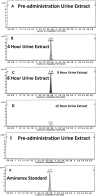Aminorex identified in horse urine following consumption of Barbarea vulgaris; a preliminary report
- PMID: 31890155
- PMCID: PMC6929286
- DOI: 10.1186/s13620-019-0153-5
Aminorex identified in horse urine following consumption of Barbarea vulgaris; a preliminary report
Abstract
Background: Aminorex, (RS)-5- Phenyl-4,5-dihydro-1,3-oxazol-2-amine, is an amphetamine-like anorectic and in the United States a Drug Enforcement Administration [DEA] Schedule 1 controlled substance. Aminorex in horse urine is usually present as a metabolite of Levamisole, an equine anthelmintic and immune stimulant. Recently, Aminorex identifications have been reported in horse urine with no history or evidence of Levamisole administration. Analysis of the urine samples suggested a botanical source, directing attention to the Brassicaceae plant family, with their contained GlucoBarbarin and Barbarin as possible sources of Aminorex. Since horsepersons face up to a 1 year suspension and a $10,000.00 fine for an Aminorex identification, the existence of natural sources of Aminorex precursors in equine feedstuffs is of importance to both individual horsepersons and the industry worldwide.
Results: Testing the hypothesis that Brassicaceae plants could give rise to Aminorex identifications in equine urine we botanically identified and harvested flowering Kentucky Barbarea vulgaris, ("Yellow Rocket") in May 2018 in Kentucky and administered the plant orally to two horses. Analysis of post-administration urine samples yielded Aminorex, showing that consumption of Kentucky Barbarea vulgaris can give rise to Aminorex identifications in equine urine.
Conclusions: Aminorex has been identified in post administration urine samples from horses fed freshly harvested flowering Kentucky Barbarea vulgaris, colloquially "Yellow Rocket". These identifications are consistent with occasional low concentration identifications of Aminorex in equine samples submitted for drug testing. The source of these Aminorex identifications is believed to be the chemically related Barbarin, found as its precursor GlucoBarbarin in Kentucky Barbarea vulgaris and related Brassicaceae plants worldwide.
Keywords: Aminorex; Barbarea vulgaris; Brassicaceae; Drug testing; Horse; Urine.
© The Author(s). 2019.
Conflict of interest statement
Competing interestsThe authors declare that they have no competing interests.
Figures





References
-
- Barker SA. The formation of Aminorex in racehorses following Levamisole administration. A quantitative and chiral analysis following synthetic Aminorex or Levamisole administration vs. Aminorex-positive samples from the field: a preliminary report. J Vet Pharmacol Ther. 2009;32(2):160–166. doi: 10.1111/j.1365-2885.2008.01015.x. - DOI - PubMed
-
- Britt B, Boyars TD. Antimicrobial drugs used by veterinarians. Proc Annu Convent AAEP. 1997;43:170–177.
LinkOut - more resources
Full Text Sources

